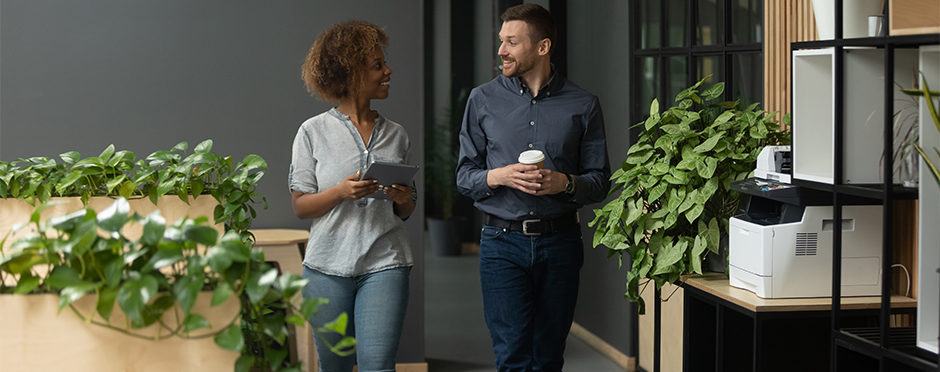
Creative Way to Get Moving When Working from the Office
Leave a CommentWhile Americans work in various industries and hold many different jobs, there’s one constant thread that can be seen through nearly all people’s work. They spend far too much of their day sitting.
Sedentary jobs have increased 83% for Americans since the 1950s, and physically active occupations make up less than 20% of all U.S. jobs. The shifting landscape of American work doesn’t seem to be reversing course anytime soon, and, unfortunately, it negatively impacts on our society’s health.
A 2019 American College of Cardiology study found that more time sitting was associated with higher rates of all-cause mortality and cardiovascular disease2. Yet, desk workers are not destined for poor health. The same study also indicated that moderate-intensity physical activity could significantly reduce or essentially eliminate the negative effects of sitting.
So, we need to move more at work, OK, but how? With seemingly endless meetings, projects, phone calls, and deadlines, who’s got the time for this? The key is not adding but incorporating movement into your work day.
Walking Calls and Meetings
Phone calls, meetings, and emails are the trinity of essential office work. Yet, there’s no rule demanding we do these tasks sitting down.
Calls that don’t require you to present information or speak frequently are excellent opportunities to walk while you listen. The same can be said for a meeting with only a few participants. Instead of sitting around a desk, take a walk around the company property while holding the meeting.
Moving while you listen isn’t just a nice idea; it can enhance your ability to focus and retain information. Your work might be more effective when movement is involved.
Walking Emails
Using the talk-to-text feature on your smart phone to reply to or compose emails is another way to add movement to your work day. Avoid errors by capturing your emails in a note-taking application and quickly copying and pasting them into the email when the task has your full attention.
All of your calls, meetings, and emails don’t need to be done walking, but there are likely some strategic times throughout your day when you could find 10-15 min to combine movement and a job task.
Standing Work
Undoubtedly work will need to be performed at the computer, and much of that work can be performed standing. Many desks can be adjusted to the standing position, or a mobile workstation can be used to complete work standing. If these are unavailable, a countertop, dresser, filing cabinet, or shelves can also be used in its palace.
Performing work in standing offers many benefits. Periods of standing have been shown to improve job performance and engagement, decrease work fatigue, and decrease daily anxiety3.
Desk Elliptical
Eventually work will need to be performed in sitting but movement can still be incorporated. Using an under the desk elliptical gives you the ability to keep your body in motion and avoid long periods of inactivity.
Performing 3-5 min of peddling at the top and bottom of every hour adds up to 48-80 min of movement during your work day.
Office Workout
Utilizing your lunch break is an ideal time to add movement into our workday, and it’s easy to use your office space as your equipment.
Many office buildings’ stairwells are woefully neglected but using the stairs can provide many health benefits. Climbing four flights of stairs at different points throughout the day has been shown to reduce fasting blood glucose levels as well as cholesterol4.
The office walls can be used for wall squats, and the desk for modified pushups or dips. Resistance bands can be connected to the office door for various arm, back, and leg exercises.
When thinking about different ways to incorporate movement into your workday, there are no added tasks to your day, and you can limit the negative effects of sitting. If pain is stopping you from moving while at work, contact your nearest Athletico for a free assessment in-clinic or virtually through our Telehealth platform.
The Athletico blog is an educational resource written by Athletico employees. Athletico bloggers are licensed professionals who abide by the code of ethics outlined by their respective professional associations. The content published in this blog is for informational purposes only, does not constitute medical advice and should not be relied on for making personal health decisions.
References:
1. Roberts, Nicole F. “Americans Sit More than Anytime in History and It’s Literally Kill-ing Us.” Forbes, Forbes Magazine, 7 Mar. 2019, https://www.forbes.com/sites/nicolefisher/2019/03/06/americans-sit-more-than-anytime-in-history-and-its-literally-killing-us/.
2. Mmanuel Stamatakis, et. al, Physical Activity, and Risk of Mortality in Adults, Journal of the American College of Cardiology, Volume 73, Issue 16, 2019, Pages 2062-2072, ISSN 0735-1097,https://doi.org/10.1016/j.jacc.2019.02.031.
3. Edwardson C L, Yates T, Biddle S J H, Davies M J, Dunstan D W, Esliger D W et al. Effectiveness of the Stand More AT (SMArT) Work intervention: cluster randomised controlled trial BMJ 2018; 363 :k3870 doi:10.1136/bmj.k3870
4. https://assets.researchsquare.com/files/rs-1551362/v1/9c0ba92b-6a9f-4c7a-b2c0-7922deb1e110.pdf?c=1652801941
